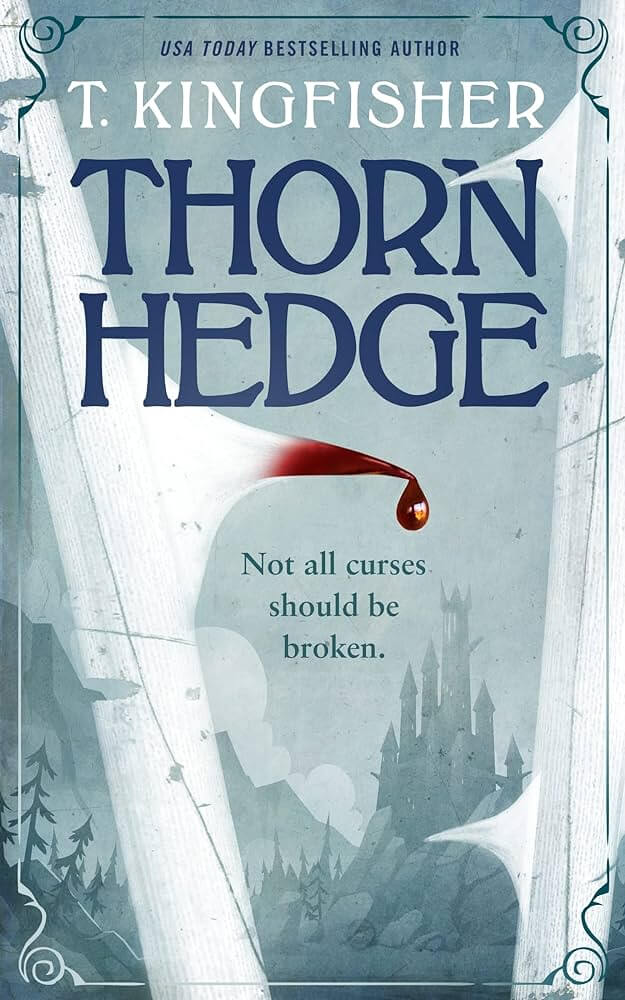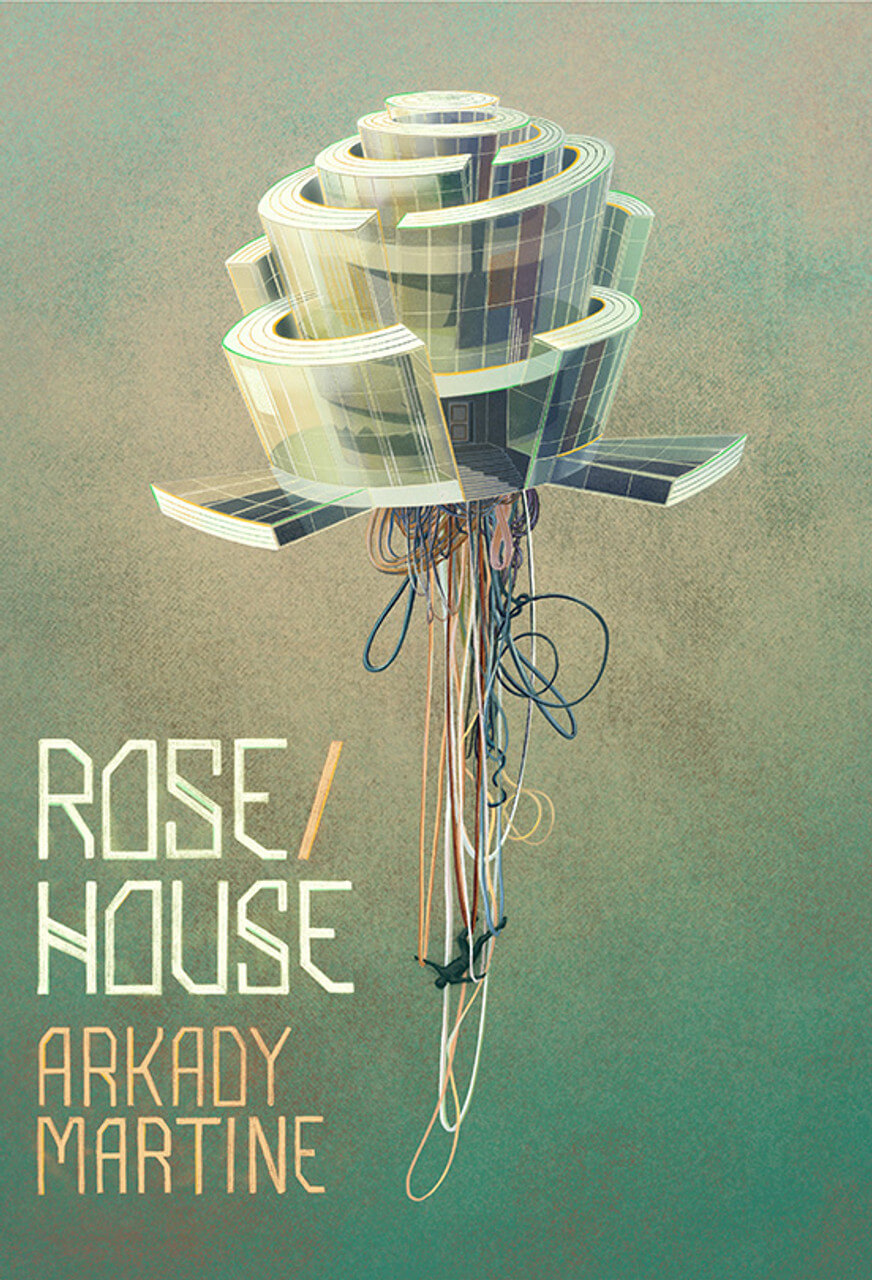It’s the end of April, there’s less than fifteen weeks until this year’s Hugo Award ceremony, and I’ve got nineteen entries in the main fiction categories to read. So what the heck, we’re doing two novellas this week instead of one. And I swear, I didn’t deliberately pick these two based on similar themes in the title. Both stories feature people who’s lives have been pulled off track, but other than that they couldn’t be more different.
Thornhedge – T. Kingfisher
“I was born human,” she said, “but things happened.”
Toadling is the least likely heroine you could imagine, but her tale would have to be twisted beyond recognition for anyone to call her a villain. She’s not quite a human being, not really a monster. Stolen by the faeries and raised by monsters who loved and adored her, she was dragged away from her happy childhood and trained for years (in fairy time, anyway) for a vitally important job that only she could do…
…which she then flubs. Badly. Fairy gifts are precise things, and God help you if you get the wording wrong.
The book begins with Toadling reflecting on many, many lifetimes of trying to fix her mistake, or at the very least keep it from getting worse. She’s spent the decades mostly in the comfortable shape of a toad, watching the thorn hedge get larger, and the surrounding countryside becoming quieter and drier. Surely, she thinks, there isn’t anyone alive who still remembers what’s at the center of the old keep.
And then a knight arrives. It’s the worst possible thing that could happen, and not just because it means there are still stories out there about the curse and the thorn hedge and the sleeper inside. For whatever reason, he’s decided that Toadling is the one who needs to be saved from a curse, and he absolutely will not give up.
“I’m not cursed!”
“Which is exactly what you’d say if you were,” he pointed out.
“But it’s exactly what I’d say if I wasn’t!”
I think another writer would have played the story as something ridiculous, a Monty Python-esq clueless Arthurian seeing curses and quests under every leaf. But in Hamin, Kingfisher has created a different type of knight here. Despite Toadling’s protests, he thinks that she’s terribly unhappy (she is) and that she’s stuck in a bad situation (which is exactly true), and he’s determined to do whatever he can to help. And that includes bringing an entire armload of charms and herbs (“I didn’t know who cursed you, or how, so I brought as many as I could find.”), and hacking his way into a magical thorn hedge, not really being too startled when the person he’s helping keeps changing into a toad in order to crawl through tiny spaces.

Kingfisher does what she does best here, with a couple of hesitant heroes caught up in a situation far over their heads. The story is told on two different tracks, following Toadling’s childhood and eventual service at the keep, and her and Hamlin’s attempt to do….something, anything, other than another few centuries keeping watch. There are a lot of moments of quiet humor in the growing friendship between them; both Toadling and Hamlin know they apologize too much and can’t seem to stop, and Hamlin knows he’s supposed to fling holy water and herbs in someone’s face to break a curse, but he can’t bring himself to do more than pat Toadling with them gently because he doesn’t want to be rude. Kingfisher also works in a lifetime of unresolved guilt at not being good enough to prevent a situation that was put in motion for reasons no one bothered to explain, plus a few horrifying allusions to what angry fairy lords could do, and one honest-to-God jumpscare, something which is pretty difficult to do in literature but which Kingfisher somehow manages with ease.
I love a good re-told fairy tale. It’s my favorite fantasy genre, especially when it’s not just looking at the same story from a side character’s viewpoint. The really tasty ones are when the author picks up the original tale and starts asking with questions. Making theories. Wondering, “What if everyone had this completely wrong?”
Rose/House – Arkady Martine
Basit Deniau’s greatest architectural triumph is the house he died in.

It’s an interesting sub-category of science fiction: architectural. Most of the action in this book takes place inside a single structure known as Rose House, and involves the genius architect who designed it. The concept sounds like it might be a little dry, except that the architect is dead and is also a diamond, the house is also an Artificial Intelligence, there’s an unidentified corpse inside that shouldn’t have been allowed to enter when he was alive, and the only person who is allowed inside was on another continent when the death happened. To make matters worse, Rose House itself notified the police about the body, but it won’t answer the police department’s questions. Thank you, go away.
This looks at first like a locked-room mystery, with some noir elements. But Rose/House is more interested in the brooding atmosphere of a house that’s been left to its own devices, and the two women who venture inside.
Dr. Selene Gisil is a former student of Basit Deniau. She separated from her mentor in a big way, publicly denouncing him and his entire architectural style, and has been making a name for herself. Until Deniau died and, for whatever reason, stipulated in his will that Selene is the only person who can enter Rose/House. She can (must?) go inside once a year to review the secret archives of all of Deniau’s work, without making copies or taking any information outside, which means for the rest of her life she’ll be the target of glory hounds and treasure seekers while her own work gets forgotten.
She’s run into Rose House alone, rather than try to explain to Detective Smith the slow poison of being Basit’s archivist, condemned to be an appendage to his legacy, all her attempts at agency stolen, remade, recontextualized into dust.
Detective Maritza Smith is the officer unlucky enough to field the call from Rose House about the inexplicable dead body. Working in a small desert community where she’s lived her entire life, growing more and more jaded about her position or the ability to actually change anything, she’s still determined to find out what the hell is going on because someone is dead and finding out what happened is her job. Even if she has to deal with an AI that answers questions in the creepiest way possible.
Anything else, Detective Smith?
“Cause of death,” said Maritza.
I’m a piece of architecture, Detective. How should I know how humans are like to die?
Most of the noir elements of the story involve Maritza’s fellow officer, Oliver Torres. And those are lampshaded by how Torres gets irritated whenever something stereotypically noir happens: the wise-cracking officer even more jaded than Maritza, trying to keep his “partner” out of trouble, dealing with a plucky journalist, showing an almost “I’m too old for this” attitude at people continuing to do dangerous things after he’s said to Not Do The Dangerous Thing.
No one aside from him was treating this business as a normal investigation, with regular check-ins and paperwork and telling your fellow detective if you were going to go radio silent inside a probably-murderous AI-controlled house, before you did that very stupid thing.
And then there’s Rose House itself. The concept of AI, literal Smart Houses, is pervasive in science-fiction, and I like how Arkady has teased out just how unsettling the reality might be. This is an entity with total control over its environment, a set of rules it needs to follow, the complete freedom to interpret those rules as it sees fit, and a mind that’s only pretending to be something close to human. And its body is a surreal glass-concrete-crystal house designed to evoke emotions just by walking from room to room.
There is, as there has always been for Selene inside one of Basit’s buildings, a sense of hypnosis. Of being led, of being let into a secret, a series of revelations, stripping away preconceptions of the shape of a building, the play of light. A slant of a hidden window illuminating. An edifice of concrete, softening, half-melted – twentieth-century Brutalism undone by erosion or heat – spilling into a pool.
Selene and Maritza wander through the maze, spiraling through Selene’s history and Maritza’s investigation and Rose House’s motivations like the arrangement of petals in a rose. There’s not a cut-and-dry answer to the mystery of whodunnit; you can’t really solve architecture, any more than you can always understand why people behave the way they do. The story gives just enough answers that the reader is left to think about all the unanswered questions.
Cover artwork for Rose/House by David Curtis.